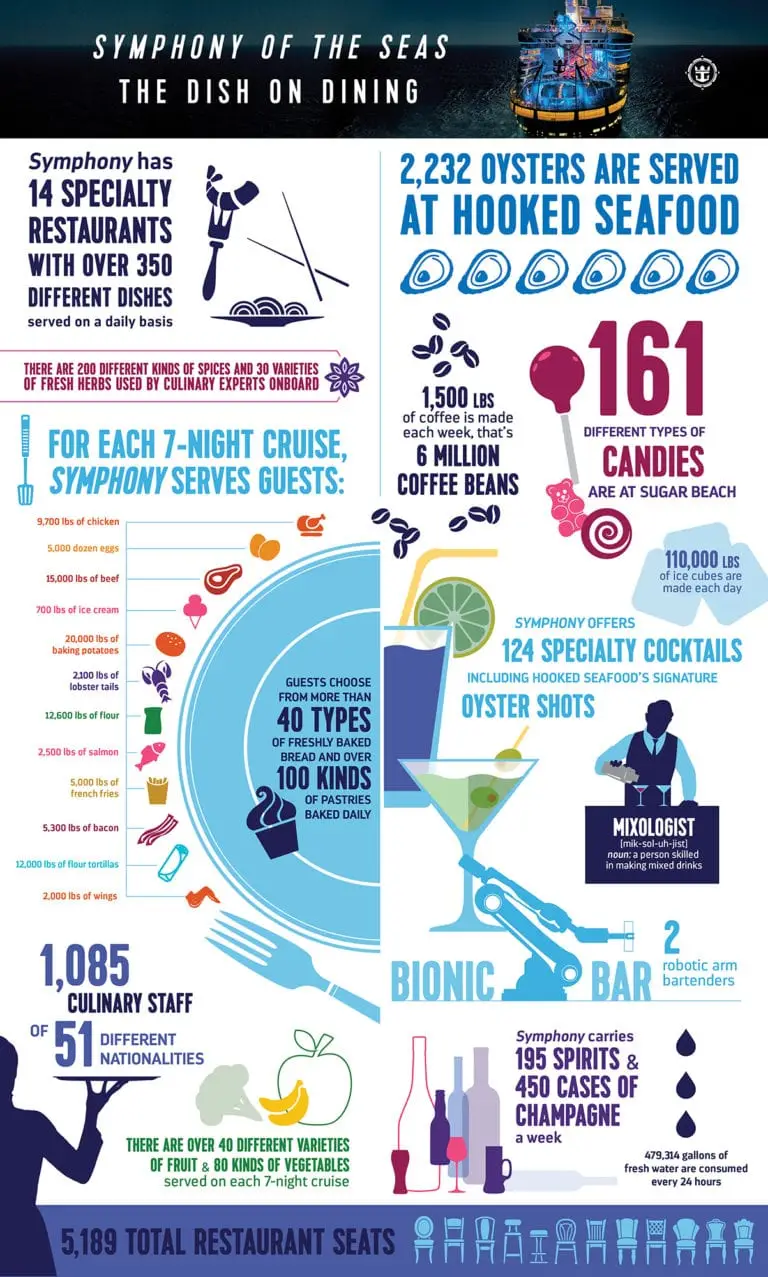You know that feeling of anxiety and confusion that comes with having dinner with a group of guests? Now imagine that in the world a largest cruise shiplike Royal Caribbean Cruises, Symphony of the Seasand provided three meals a day to 30,000 passengers every day for a week!
Shopping for dine-in guests can be tiring, so consider ordering for 6,600 passengers! The inventory manager aboard Symphony of the Seas has a $1 million weekly grocery budget to stock the ship’s many restaurants.
we need a bigger boat
Symphony of the Seas’ weekly food supply requires 30 trucks carrying 500 pallets of food and drink. The grain weighs approximately 600,000 pounds. Putting away a load of groceries is a nightmare!
Food preparation never stops on most cruise ships. There’s breakfast, lunch, dinner, snacks, and 24-hour food and room service in at least one or two areas. For the cooks and crew, this is all they do, with no breaks for much of the voyage.
A large ship like Symphony of the Seas will have more than 200 chefs, about 1,000 employees and 36 different galleys.
Watch this YouTube video to get an idea of what it looks like:
How one of the world’s largest cruise ships serves 30,000 meals a day
How much do meals cost on a cruise line?
Meals on a cruise usually cost around $12 – $15 per person per night. On average, cruise lines expect to spend about 6% of the fare paid by each passenger on food.
This is a reasonable cost per person that would be difficult to replicate on land. Cruise lines benefit from economies of scale and lower costs because they buy in such large volumes.
Cruise lines often complete the same journeys with similar passengers, and this commonality allows them to predict the amount and type of food with a high degree of accuracy. This helps reduce waste, and most cruise ships do a good job of keeping waste to a minimum.
Cruise Meals by the Numbers
Here are some of the costs experienced on a seven-day cruise on a larger cruise ship like the Symphony of the Seas.
- 1,500 pounds of coffee
- 60,000 eggs
- 9,700 pounds of chicken
- 15,000 pounds of beef
- 18,680 hot dogs
- 700 pounds of ice cream
- 20,000 pounds of potatoes
- 2,100 pounds of lobster tails
- 12,600 pounds of flour
- 2,500 pounds of salmon
- 5,000 pounds of French fries.
- 5,300 pounds of bacon
- 12,000 pounds of tortillas
- 2,000 pounds of wings.
- 2,000 pounds of shrimp
- 4,850 pounds of strawberries
- 8,800 pounds of tomatoes
- 21,000 ice cream cones
- 44,000 bread rolls
- 67,500 pastries
It’s not just bread and water
All these foods make people thirsty, so water alone consumes nearly 500,000 gallons of fresh water every day.
To keep the water cold, 120,000 pounds of ice are produced every day. That doesn’t include 28,000 bottles and cans of beer!
Although Betty Crocker She loves baking and has to make 40 kinds of freshly baked bread and more than 100 kinds of pastries every day, which is a difficult task for her.

Infographic from Symphony of the Seas
Fighting food waste on cruise ships
Most cruise lines, especially the larger ones, take various steps to avoid food waste.
Royal Caribbean has proprietary technology that tracks the amount of food waste. One of the strategies used is to weigh the lasagna pans before and after serving. Based on the information obtained, RC modifies production accordingly.
Royal Caribbean also uses point-of-sale data to help predict how much food will be used based on passenger demographics, itineraries or other information.
For example, if a cruise ship has a large portion of children, of which Disney is one, they naturally know they need more chicken fingers than if most of the passengers were adults.
Cruise lines take various measures to avoid food waste as this is not only environmentally responsible but also helps reduce costs.
Here are some common practices and strategies cruise lines use to reduce food waste:
Menu planning
Careful menu planning is essential to ensure that the amount of food ordered and prepared is sufficient for passengers.
Cruise lines often design menus to minimize the use of perishable ingredients.
portion control
Cruise ships often serve meals in portion-controlled portions to reduce the possibility of leftovers.
Self-service dining areas may have staff portioning out food to prevent over portioning.
Real-time monitoring
Some cruise lines are using technology to monitor food consumption trends in real time, helping them adjust food production accordingly.
Donation program
Many cruise lines have partnerships with local charities or food banks port of call Donate leftover food that cannot be used on the ship.
staff training
Crew members are regularly trained on being mindful of food waste and may receive training in portion control, food handling and preservation techniques.
Recycling and composting
Cruise ships often have recycling and composting programs to manage food scraps and packaging waste more sustainably.
Repurpose leftovers
Leftover food can sometimes be creatively repurposed into new dishes or incorporated into staff meals to minimize waste.
sustainable sourcing
Cruise lines may prioritize sourcing food locally at port destinations to reduce the need for excess food storage and minimize waste.
Guest education
Some cruise lines educate passengers on the importance of reducing food waste and encourage them to be mindful of their consumption.
food waste tracking
Cruise lines can track and analyze food waste data to identify areas for improvement and set goals for reducing waste.
Adjustment menu
Cruise lines may adjust menus based on passenger preferences and consumption patterns to minimize the production of unpopular dishes.
Partially customized
Some cruise lines offer passengers the option to customize portion sizes, allowing them to choose smaller portions to reduce food waste.
final thoughts
The staggering amount of food required on board a cruise ship is a testament to the complex logistics of maintaining these floating cities. It offers passengers diverse culinary experiences and cultural immersion.
However, it also highlights the importance of responsible food management to minimize waste, reduce environmental impact and ensure the sustainability of this remarkable industry.
Cruise lines strive to balance luxurious onboard dining with sustainable practices to create a fun and enjoyable vacation.
This page contains affiliate links, which may result in us receiving financial compensation when a purchase is made through one of our affiliate partners.
about
Joy is the co-founder and content manager/expert of CruisePortAdvisor.com, where she is also one of the site’s founders. She enjoys traveling, singing and baking.
Source link

